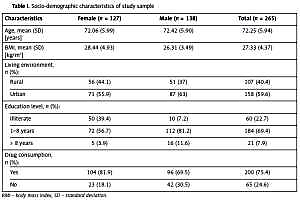Current issue
Archive
Manuscripts accepted
About the Journal
Editorial office
Editorial board
Section Editors
Abstracting and indexing
Subscription
Contact
Ethical standards and procedures
Most read articles
Instructions for authors
Article Processing Charge (APC)
Regulations of paying article processing charge (APC)
GERIATRICS / CLINICAL RESEARCH
Factors affecting body awareness in older adults with chronic musculoskeletal pain
1
Kinikli Campus, School of Physical Therapy, Pamukkale University, Denizli, Turkey
Submission date: 2018-04-12
Final revision date: 2018-08-13
Acceptance date: 2018-09-08
Online publication date: 2019-07-17
Publication date: 2021-07-16
Arch Med Sci 2021;17(4):934-939
KEYWORDS
TOPICS
ABSTRACT
Introduction:
Chronic musculoskeletal pain (CMP) and cognitive impairment (CI) may reduce body awareness in older adults. The first aim of this study was to determine the impact of CMP and CI on body awareness in older adults. The second was to search for the factors most affecting body awareness using logistic regression analysis.
Material and methods:
Two hundred and 65 older adults (males: 138 and females: 127) aged 65 and over (mean age; 72.27 ±6.42 years) living in their own homes were included. We used the following evaluation methods: CMP intensity (Visual Analog Scale – VAS), cognitive status (Hodkinson’s Abbreviated Mental Test – HAMT), and body awareness (Body Awareness Questionnaire – BAQ). Logistic regression analysis was used to determine the factor most affecting the BAQ score.
Results:
Eighty-five point two percent of participants (n = 265) reported CMP (lower extremity pain: 74.6%; spinal pain: 66.6%; upper extremities pain: 44.4%). CMP intensity was higher in lower extremities (mean VAS: 5.73 ±1.86 cm). Gender differences in terms of CMP were found in favor of males (p = 0.0001). Mean HAMT score was 8.16±1.65. Gender difference in favor of males was significant (p = 0.0001). Mean BAQ score was 77.61±20.90; there was no significant difference between the gender (p = 0.142). There was a significant moderate positive correlation between body awareness and cognitive status (r = 0.382, p = 0.0001). However, a weak negative correlation was found between body awareness and pain intensity (r = –0.234, p = 0.0001). Regression analysis showed that living environment (rural area), low education level, low cognition level and increased CMP intensity significantly predicted body awareness.
Conclusions:
The results obtained from this study indicate that cognitive impairment and pain should be reduced by improving body awareness among older adults. That is why health professionals should evaluate all related factors affecting body awareness before planning the most suitable rehabilitation program.
Chronic musculoskeletal pain (CMP) and cognitive impairment (CI) may reduce body awareness in older adults. The first aim of this study was to determine the impact of CMP and CI on body awareness in older adults. The second was to search for the factors most affecting body awareness using logistic regression analysis.
Material and methods:
Two hundred and 65 older adults (males: 138 and females: 127) aged 65 and over (mean age; 72.27 ±6.42 years) living in their own homes were included. We used the following evaluation methods: CMP intensity (Visual Analog Scale – VAS), cognitive status (Hodkinson’s Abbreviated Mental Test – HAMT), and body awareness (Body Awareness Questionnaire – BAQ). Logistic regression analysis was used to determine the factor most affecting the BAQ score.
Results:
Eighty-five point two percent of participants (n = 265) reported CMP (lower extremity pain: 74.6%; spinal pain: 66.6%; upper extremities pain: 44.4%). CMP intensity was higher in lower extremities (mean VAS: 5.73 ±1.86 cm). Gender differences in terms of CMP were found in favor of males (p = 0.0001). Mean HAMT score was 8.16±1.65. Gender difference in favor of males was significant (p = 0.0001). Mean BAQ score was 77.61±20.90; there was no significant difference between the gender (p = 0.142). There was a significant moderate positive correlation between body awareness and cognitive status (r = 0.382, p = 0.0001). However, a weak negative correlation was found between body awareness and pain intensity (r = –0.234, p = 0.0001). Regression analysis showed that living environment (rural area), low education level, low cognition level and increased CMP intensity significantly predicted body awareness.
Conclusions:
The results obtained from this study indicate that cognitive impairment and pain should be reduced by improving body awareness among older adults. That is why health professionals should evaluate all related factors affecting body awareness before planning the most suitable rehabilitation program.
Share
RELATED ARTICLE
We process personal data collected when visiting the website. The function of obtaining information about users and their behavior is carried out by voluntarily entered information in forms and saving cookies in end devices. Data, including cookies, are used to provide services, improve the user experience and to analyze the traffic in accordance with the Privacy policy. Data are also collected and processed by Google Analytics tool (more).
You can change cookies settings in your browser. Restricted use of cookies in the browser configuration may affect some functionalities of the website.
You can change cookies settings in your browser. Restricted use of cookies in the browser configuration may affect some functionalities of the website.



